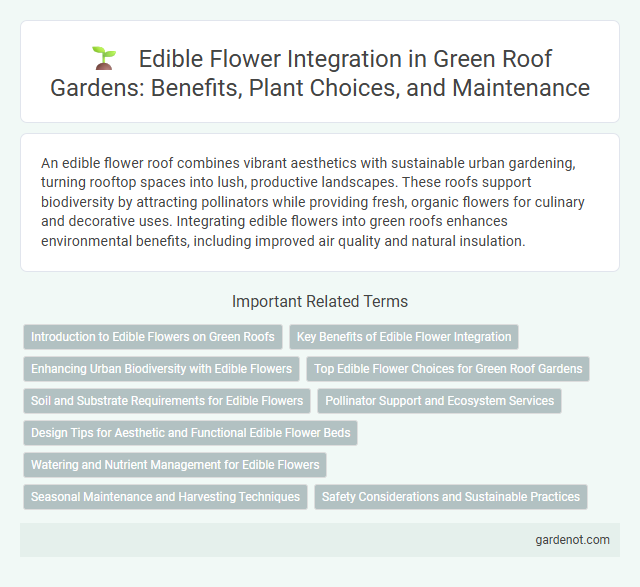An edible flower roof combines vibrant aesthetics with sustainable urban gardening, turning rooftop spaces into lush, productive landscapes. These roofs support biodiversity by attracting pollinators while providing fresh, organic flowers for culinary and decorative uses. Integrating edible flowers into green roofs enhances environmental benefits, including improved air quality and natural insulation.
Introduction to Edible Flowers on Green Roofs
Edible flowers on green roofs provide a sustainable and visually appealing way to maximize urban gardening space while promoting biodiversity. Varieties such as nasturtiums, pansies, and calendulas thrive in shallow soil and offer vibrant colors alongside culinary and medicinal benefits. Integrating these flowers enhances rooftop ecosystems by attracting pollinators and improving microclimate regulation.
Key Benefits of Edible Flower Integration
Integrating edible flowers into green roofs enhances biodiversity by attracting pollinators such as bees and butterflies, which improves overall ecosystem health. These flowers contribute to urban food security by providing fresh, nutrient-rich harvests directly from rooftop gardens. Their natural beauty adds aesthetic value, reducing stress and promoting mental well-being in urban environments.
Enhancing Urban Biodiversity with Edible Flowers
Edible flower roofs contribute significantly to enhancing urban biodiversity by providing habitat and food sources for pollinators such as bees and butterflies. These green roofs support ecological networks in cities, increasing native plant diversity while promoting sustainable food production. Integrating edible flowers into rooftop gardens fosters resilience in urban ecosystems by improving pollinator populations and enriching local wildlife habitats.
Top Edible Flower Choices for Green Roof Gardens
Top edible flower choices for green roof gardens include nasturtiums, calendula, and pansies, prized for their vibrant colors and culinary uses. Nasturtiums offer peppery leaves and blossoms rich in vitamin C, while calendula petals provide a tangy flavor and medicinal properties. Pansies add mild, sweet notes and are easy to cultivate in rooftop environments, contributing to both aesthetics and sustainable urban agriculture.
Soil and Substrate Requirements for Edible Flowers
Edible flower roofs require a well-draining, nutrient-rich substrate to support healthy plant growth and vibrant blooms. A lightweight, organic soil mix with a balanced pH between 6.0 and 7.0 promotes optimal nutrient availability and moisture retention. Incorporating compost and small amounts of perlite or vermiculite enhances aeration and water drainage essential for delicate edible flowers.
Pollinator Support and Ecosystem Services
Edible flower roofs enhance pollinator support by providing diverse nectar and pollen sources that attract bees, butterflies, and other beneficial insects vital for urban biodiversity. These green roofs contribute to ecosystem services such as air purification, temperature regulation, and stormwater management while promoting sustainable food production. Integrating edible flowers maximizes habitat complexity, fostering resilient urban ecosystems and supporting pollination networks essential for both natural and agricultural environments.
Design Tips for Aesthetic and Functional Edible Flower Beds
Design edible flower beds on green roofs by selecting native, pollinator-friendly species such as nasturtiums, pansies, and calendula to enhance biodiversity and visual appeal. Use layered planting techniques combining low, medium, and tall flowers to create depth and maximize space while ensuring proper drainage and soil quality for plant health. Incorporate modular planting systems and accessible pathways to facilitate maintenance and harvesting, balancing aesthetics with practical functionality.
Watering and Nutrient Management for Edible Flowers
Optimal watering for edible flower roofs requires consistent moisture without waterlogging, using drip irrigation systems to maintain soil hydration at 60-70% field capacity. Nutrient management involves organic fertilizers rich in phosphorus and potassium to promote vibrant blooms and healthy growth, supplemented by periodic foliar feeding with micronutrients like iron and magnesium. Monitoring soil pH around 6.0 to 6.5 ensures nutrient availability and maximizes flower vitality on green roofs.
Seasonal Maintenance and Harvesting Techniques
Edible flower roofs require regular seasonal maintenance, including pruning spent blooms and monitoring soil moisture to promote continuous flowering and plant health. Harvesting techniques involve picking flowers early in the morning when their flavor and fragrance are most potent, using clean scissors to avoid damaging the plants. Proper timing and gentle handling ensure the longevity of the edible flower crops and enhance the roof's aesthetic and ecological benefits.
Safety Considerations and Sustainable Practices
Edible flower roofs require strict adherence to safety considerations, including the use of non-toxic, pesticide-free plants to prevent contamination and ensure safe consumption. Sustainable practices involve selecting native or well-adapted flower species to reduce water usage and promote biodiversity, alongside organic soil amendments to maintain healthy growth without harmful chemicals. Regular monitoring for pollutants and maintaining proper drainage systems help sustain the roof's environmental benefits while safeguarding human health.
Edible flower roof Infographic

 gardenot.com
gardenot.com